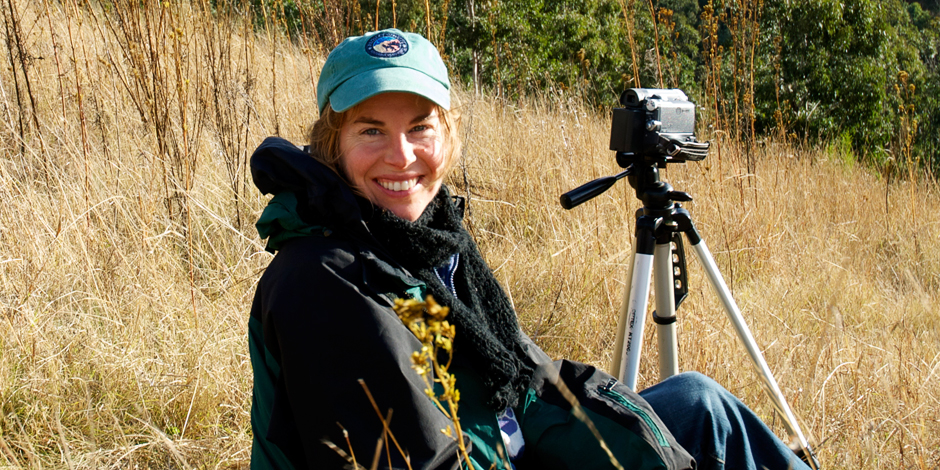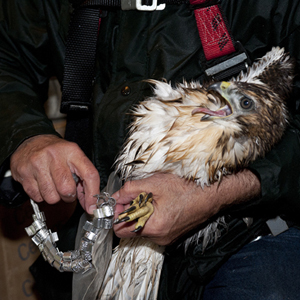Their eerie howl wakes residents of cities as populous as New York and Chicago. They are known to tote away the neighbor’s cat for a midnight snack. And in rural areas, they enter pens and kill livestock. The human response has been expensive. Every year, half a million coyotes are trapped, poisoned, and snared, and aerial gunning with low-flying aircraft or helicopters has also been used, with much of the cost going to taxpayers, making coyotes the most outlawed native carnivore in the United States. Camilla Fox (CAS’91) believes she has a better solution.
Fox, who has seen the limitations of cash- and staff-strapped wildlife agencies and the carnage of coyote eradication, founded Project Coyote in 2008. The nonprofit aims to change the way coyotes and other wild carnivores are viewed and treated in this country.
The number of human-coyote encounters has risen over the last century for many reasons, but the main ones are the coyotes’ ascendance to the position of top predator following the near eradication of wolves, and the continuing encroachment of society into their forest habitat.
“Coyotes have learned to coexist with us because they are adaptable, resilient, and intelligent animals,” says Fox, who is executive director of the organization, based in Larkspur, Calif. “But we haven’t quite learned to do that yet with them.”
Fox grew up in St. Louis, Mo., and in Maine with a pet timber wolf named Tiny that had been rescued from a research facility by her father, a veterinarian, wild canid researcher, and former vice president of the Humane Society of the United States. While Fox doesn’t advocate wild animals as pets, she says the experience instilled in her a love for four-legged creatures.
At BU, Fox cofounded Boston University Students for the Ethical Treatment of Animals, and after graduation she went to California to work for animal protection and environmental advocacy nonprofits. She later earned a master’s degree in environmental studies from Prescott College. In her work with conservation groups, she saw a need—and a better way—to protect carnivores. Fox says the U.S. Department of Agriculture’s Wildlife Services alone spends $160 million a year to kill close to 5 million animals, 80,000 to 90,000 of which are coyotes.
Project Coyote, which has 20 staff members and volunteers around the country, is often contacted by people who are dismayed to learn that their town is planning a campaign to trap and kill coyotes. The organization works with communities to develop coexistence plans to strategically “haze” coyotes—using deterrents to move an animal out of an area or to discourage undesirable behavior. Fox says the group’s more humane techniques can significantly reduce, if not eliminate, negative interactions between coyotes and humans. Her group also educates communities, urging people not to leave food and small pets outside, for example.
When contacted by communities, Project Coyote teaches them to haze the coyotes, which involves showing residents, animal control officers, and parks staff how to use consistent and persistent deterrents—making loud noises, for example, spraying the animals with water, shining bright lights, throwing objects, and even chasing the coyotes away. The maneuvers are intended to discourage coyotes from returning to the town to find food. And that, in turn, keeps them from being killed, Fox says.
She points to success stories like Marin County, Calif., which spent $60,000 annually to kill coyotes before officials there contacted her group. Now the county employs Project Coyote’s strategies, using llamas (which protect sheep by emitting a warning sound and kicking coyotes), guard dogs, and electric fencing to protect sheep and other animals on the coyote menu.
Project Coyote tailors plans to suit specific cities and towns, which have included San Francisco, Superior, Colo., and Davis, Calif. So far, Fox says, the feedback has been enthusiastic. “Communities get to see the positives of living with coyotes and other wildlife—essentially being a wildlife-friendly community,” she says, “and the positive media and PR they receive.”
Fox wants people to know that a healthy coyote population is vital in the food chain. Coyotes and other predators keep species like rodents and other pests in check. On the East Coast, they cull the deer population, which in turn lowers the prevalence of Lyme disease. And many scavenger animals, such as ravens and foxes, depend on the carcasses left behind by coyotes.
“For a lot of people, their first encounter with a predator species might be a coyote in their midst,” says Fox, who was honored in 2006 with the Humanitarian of the Year Award from the Marin Humane Society and has received a Christine Stevens Wildlife Award from the Washington, D.C.–based Animal Welfare Institute. “So Project Coyote wants to help individuals and communities understand coyotes and understand the important ecological role that predators play in our ecosystem. Appreciate them or not, they are here to stay.”

















































Keep your head up, and don’t listen to these haters! Everyone is entitled to their own opinions. I enjoyed reading your article.
Ms Farr,
Your articles are not a reliable source to provide any proof. Here are my “citations”: links to the actual County documents that show beyond a shadow of a doubt that Camilla Fox had nothing to do with the introduction of the nonlethal plan Marin County is currently using, and that she is taking credit for something she did not accomplish. See for yourself:
See #6. Funding for Non-lethal Program Activities: Northbay Woolgrowers Association:
http://www.co.marin.ca.us/depts/BS/main/agdocs/001031-wildlife.pdf
See Item 21. Meeting Minutes:
http://www.co.marin.ca.us/EFiles/BS/AgMn/minsags/m001031.txt
Gina,
Are you sure you were living in Marin at that time? It’s hard for me to believe that you don’t remember the Board of Supervisor’s meeting where Little Blue Society presented their program to the County, that was included in Mr. Carlsen’s livestock protection plan. I remember it distinctly because a very close friend of mine raises sheep in Marin and I was at every contentious meeting there was with this woman Camilla and her group. As I recall this alternate program was a big deal. I agree with Aaron that Camilla did not introduce this program she is claiming she introduced.
Rose
Thank goodness for Camilla Fox and Project Coyote (PC)! In 2000 in Corrales, NM, when I learned the animal control officers and the resident Wildlife Services officer were shooting and leghold-trapping adult coyotes and asphyxiating pups in the den, I found the nascent PC and Camilla. Camilla has been an always-available advisor and an encouraging presence all this time as I, first, and then other residents struggled to change the attitudes of and the control methods used by officials and much of the citizenry from fear/anger and killing as the immediate response to the understanding of behavior and the use of humane management. Although a few residents display ignorance and self-interest occasionally, to most residents coyotes are a joy to observe and hear, or they are a non-issue. Camilla, Board of Directors, PC: Thank you!
You are right, Aaron, that this issue started as a polarized debate in Marin County between ranchers and conservationists. I’ve lived in Marin for over 50 years and know these local issues well. You are wrong that Camilla Fox was not pivotal in commandeering the shift from lethal control to non-lethal and Marin County’s adoption of the Marin County Livestock & Wildlife Protection Program. I don’t see any citations to prove your points, just emotional nonsense (what’s your beef with Camilla, I wonder), but I’m attaching several to prove mine.
The truth is in action and words, and here are Stacy Carlsen’s words to prove it (Mr. Carlsen is the Marin County Ag Commissioner who worked with Camilla and the ranchers in developing this model program):
Read here: http://www.sfgate.com/science/article/Ranchers-shift-from-traps-to-dogs-to-fight-coyotes-3514405.php
And here: http://cemarin.ucanr.edu/newsletters/November_200523660.pdf
And here: http://awionline.org/pubs/Quarterly/08-57-03/08_57_3p11.htm
And here: http://www.sandiegolovesgreen.com/the-marin-county-livestock-wildlife-protection-program-a-non-lethal-model-for-coexistence/
And listen here: http://www.youtube.com/watch?v=A9FBbMh9sNM&feature=c4-overview&list=UUkym5skT4cdkk_wPY9GmKCw
Camilla Fox and her organization are based in Marin County and actively promote coexistence and work collaboratively with agencies countywide toward this goal. I’ve never heard of or seen “Little Blue Society” do one thing in Marin County. In fact, there’s no such organization with that name based here in Marin, and certainly if they exist, they were not present (as I was) during the formation of this now national model.
On a personal note, I was so impressed with the work Camilla and Commissioner Carlsen did those years ago that I now work for Project Coyote, and am proud to say so! And as a Marin native, I’m also proud of my county for being so practical and forward thinking.
Get your facts straight, Aaron, before you post inane and unsubstantiated comments like this. This really burned me up!
How about researching the truth before printing articles? I used to live in Marin County in the early 2000s – and remember distinctly what a contentious battle it was between Ms. Fox’s group and the sheep ranchers, and how the issue was completely polarized.
Camilla Fox did not introduce the nonlethal program to the county; it was another group called Little Blue Society (I remember that name well because I thought it was an incredibly innovative program at the time). Little Blue Society was invited by the Ag Commissioner and presented the program they designed that the county later used.
Ms. Fox’s shameless self-promotion and habit of taking other peoples’ credit and rewriting history is absolutely mind-blowing!
Not a Fan,
Aaron
You can find our Field Guide to Coyote Hazing as well as additional tools, tips, and information about how to reduce conflicts with coyotes at Project Coyote’s website (http://www.ProjectCoyote.org). To download a free copy of our Field Guide to Coyote Hazing, visit
http://www.projectcoyote.org/resources.html#hazing.
Where can I get the hazing program details? We need this type of action in our Toronto neighbourhood, where a coywolf has been attacking and killing dogs (not all small) for the past three years.
Thanks
Chris